No bread flour? No problem! Learn how to bake artisan sourdough bread using all purpose flour and active sourdough starter. This easy-to-follow recipe features step-by-step photos, helpful tips, and a simple baking schedule to help you create delicious, naturally leavened loaves at home. It’s light crisp and airy!

Bakers all over the world choose bread flour to create exceptional sourdough bread at home. It’s prized for its high protein and gluten content, which helps to create a lofty-high rise. But what if you don’t have any bread flour? Can you make light, airy artisan sourdough with all purpose flour instead?
In this post, you’ll find a clear, step-by-step guide to mastering sourdough with all purpose (or “plain”) flour with a few key adjustments. You’ll gain the tools and confidence you need to bake delicious bread everytime.
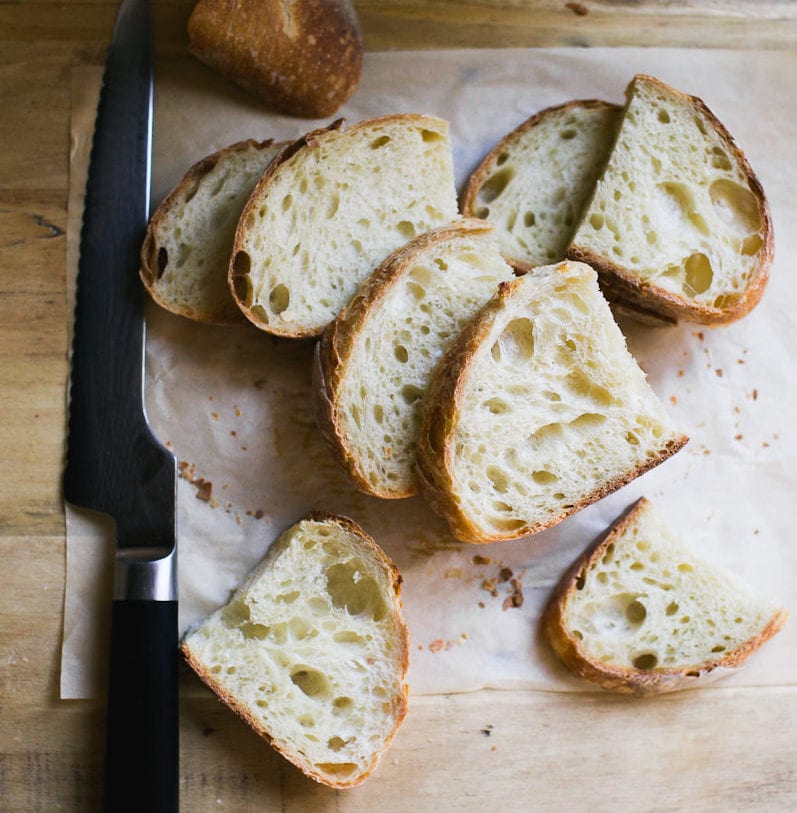
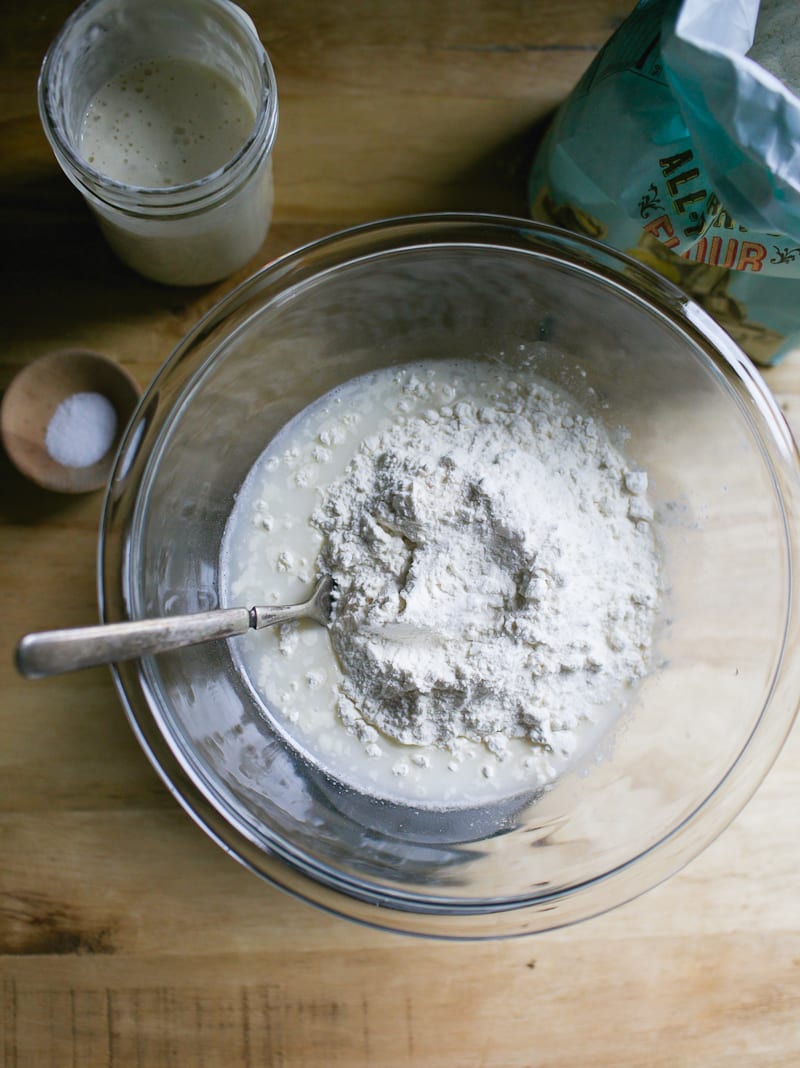
All-Purpose Flour vs. Bread Flour: Key Differences
It all boils down to protein content. Bread flour has a higher protein content than all purpose flour, which affects gluten development and the bread’s rise.
I typically use King Arthur flour for bread baking. Their bread flour contains 12.7% protein, and their all purpose flour contains 11.7%. This recipe was formulated to work with King Arthur and Trader Joe’s all purpose flours, which are comparable. (learn more about choosing flour in this post).
Tip: Protein content varies between brands, so stick to one brand first to understand how it behaves. It will be your reference point for future adjustments as you continue to bake.
How to Use All Purpose Flour in Bread Baking
Swapping all-purpose flour for bread flour is not always an even exchange. Because all-purpose flour absorbs less water, you’ll need to reduce the total water in your dough to avoid stickiness. Too much water makes the dough hard to handle, which can cause flat, dense, or gummy bread- you don’t want that.
Ok, So Reduce the Water by How Much?
I typically suggest reducing the water by 15-30g to start. The range depends on the specific sourdough recipe, the amount of sourdough starter, and the flour brand you use.
You’ll have to play around with the texture of the dough, adjusting the flour/water as needed until it “feels right,” which can be frustrating if you lack experience. But stick with it: success requires practice, patience and persistence. For now, let’s focus on visual and tactile cues to guide you through the process.
How to Make Artisan Sourdough Bread with All Purpose Flour {Step-By-Step Recipe}
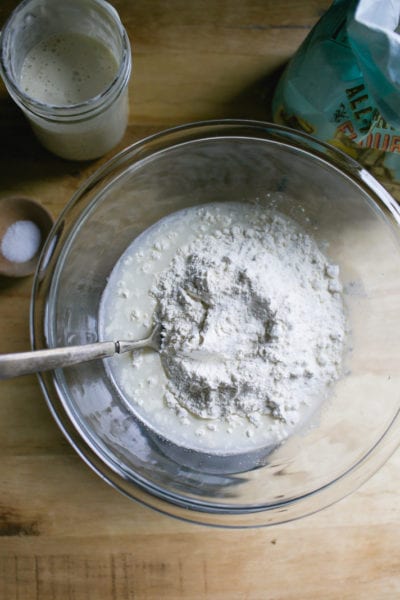
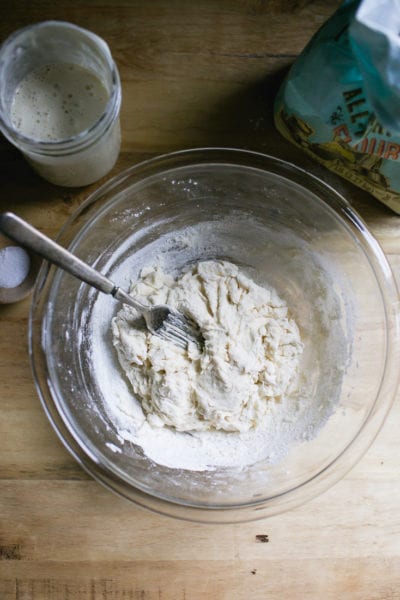
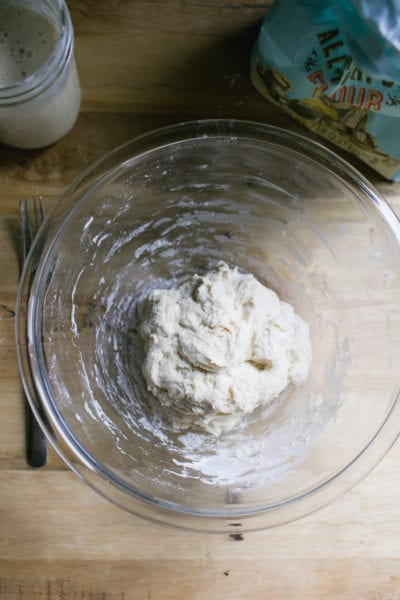
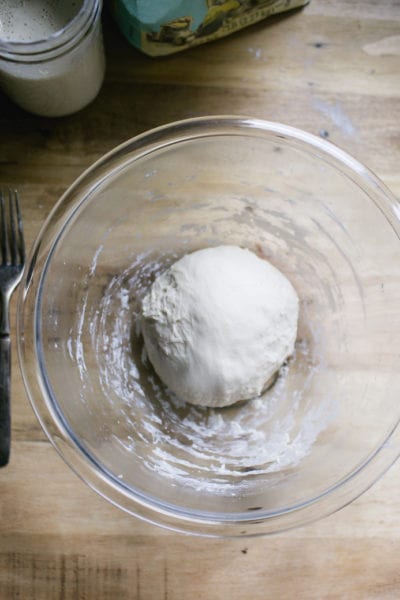
Mix the Dough
- In a large bowl, whisk your bubbly starter and water together. Add the flour and salt, then mix with a fork until combined. When the dough becomes too stiff to mix with a fork, switch to your hands and knead gently until a rough, shaggy dough forms.
- This texture is what you’re looking for: slightly sticky but holding together (see image below). Now, cover the bowl with a damp towel or plastic wrap and let rest at room temperature for 30 minutes.
- After the dough has rested, work it into a ball. The surface will appear mostly smooth with a few tears. This is your last chance to adjust the dough’s texture before the bulk rise, so pay attention to how it feels. The dough should be soft and stretchy- not wet, overly sticky, or soupy.
A Few Notes: This recipe makes a small sourdough loaf, ideal for 2–4 people. Smaller loaves are easier to handle, especially if you’re new to sourdough baking. Instructions for a larger loaf are at the end of this post. For best results, you’ll want a digital kitchen scale to measure ingredients accurately, and a Dutch oven (or similar lidded oven-safe pot) for baking. You can find these tools in my shop.
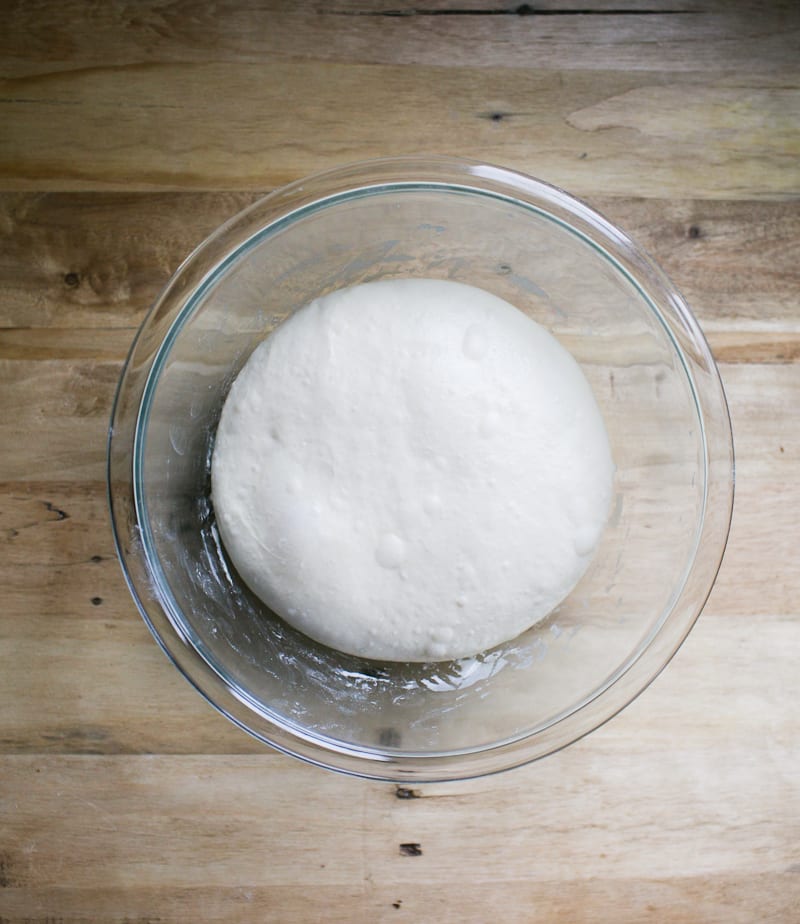
Bulk Rise
Cover the bowl and let rise overnight, about 10-12 hrs. at room temperature (68 F). The dough is ready when it has doubled in size and looks light and airy. If you’re using a standard 8-inch mixing bowl, the dough should rise to about halfway or two-thirds up the sides, which is perfect for this small loaf.
Optional: Stretch and Fold
This step, done during the bulk rise, helps to strengthen the gluten, improve structure, and give your loaf more height. Watch the video below for additional guidance.
About 30 minutes into the rise, perform your first stretch and fold:
- Gently grab one side of the dough, stretch it upward, then fold it over toward the center.
- Rotate the bowl a quarter turn and repeat.
- Continue until you’ve completed four folds (one full set).
- Repeat once more, 30 to 60 minutes later.
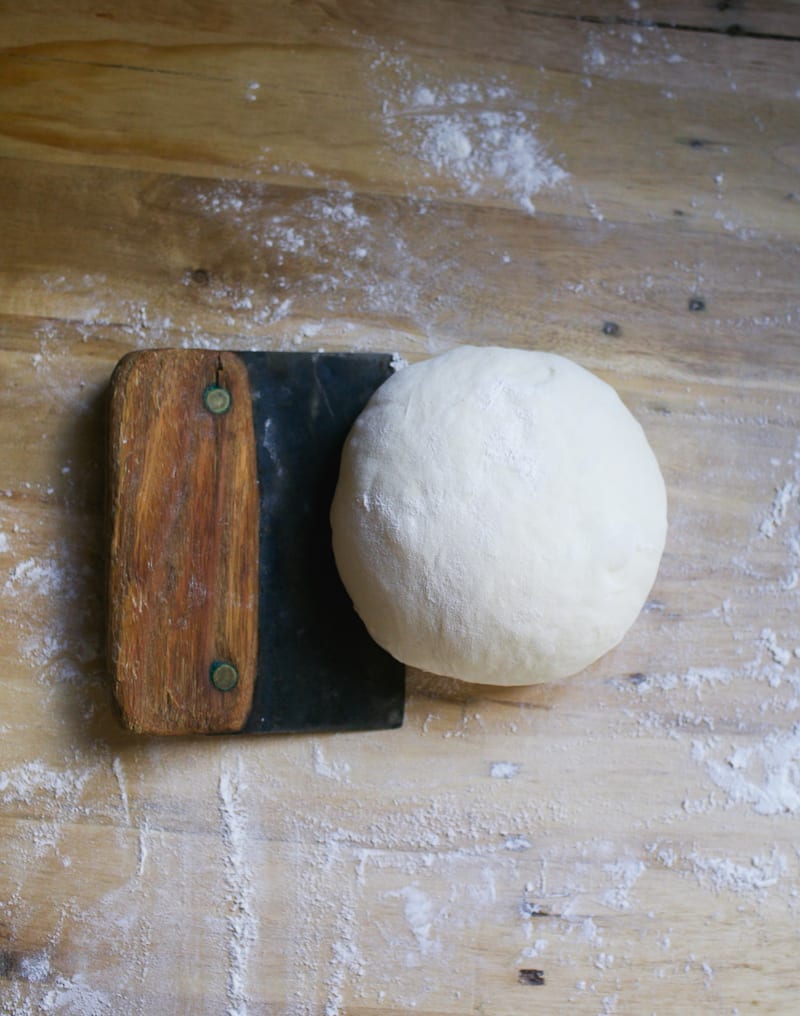
Shape The Dough
- Line a small bowl with a cotton or linen cloth. Sprinkle generously with flour. Now, you’ll shape the dough twice: first to preshape it, then to build strength and structure.
- Preshape: Remove the dough onto a floured surface. Gently fold the top edge of the dough toward the center. Turn it slightly and repeat, working in a circle until the dough forms a round. Use a bench knife to flip the dough over (smooth side up), then cover and let rest for 20–30 minutes.
- Final Shape: After resting, flip the dough again so the smooth side is facing down. Repeat the folding process to form a tight round. Then flip it back over. With floured hands, gently pull the dough toward you in a circular motion to tighten the shape. Place the dough into the lined bowl, seam side up. Cover the dough with the cloth overhang.
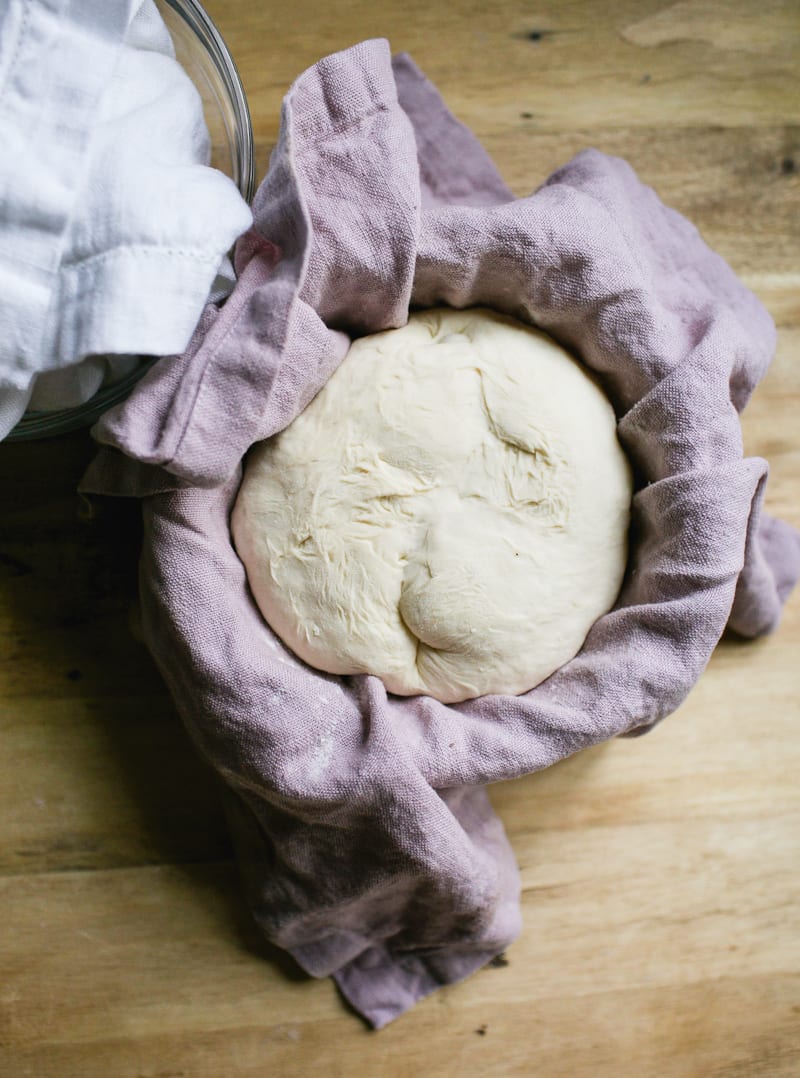
Second Rise
Let the dough rest at room temperature for 30 minutes to 1 hour. It’s ready when it looks plump and slightly puffed—it won’t double in size during this stage. While the dough is rising, preheat your oven to 450°F.
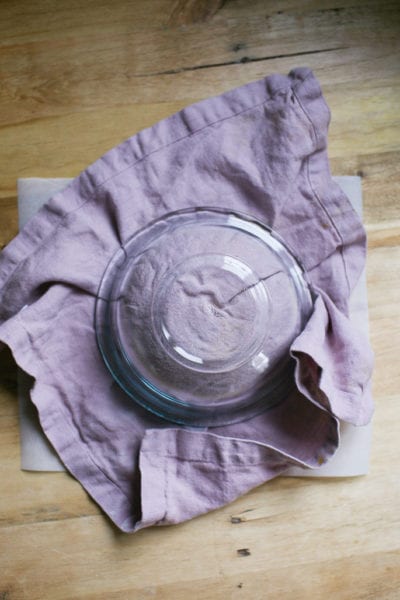
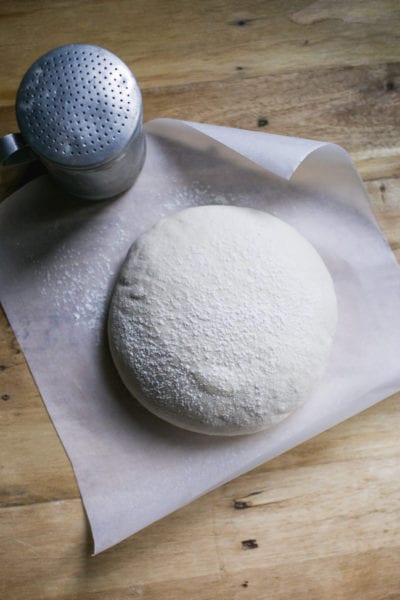
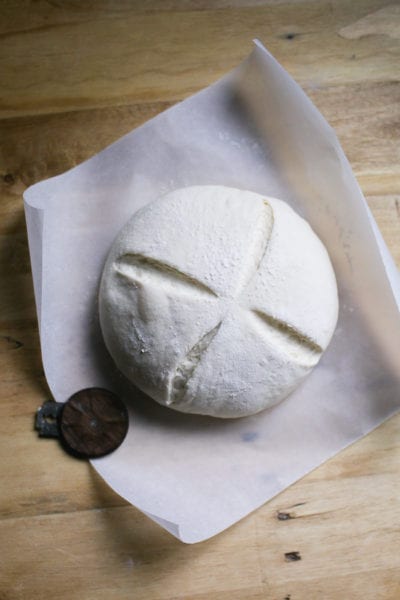
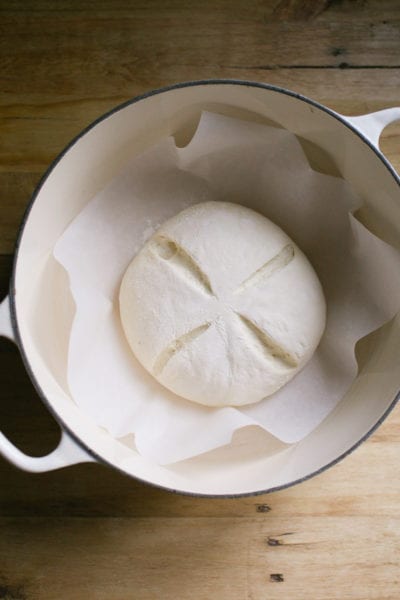
Score The Dough
- Invert the bowl of dough onto a sheet of parchment paper. Remove the bowl and cloth.
- Sprinkle the dough with flour and smooth the surface with your hands.
- Using a bread lame or a small serrated knife (I used my UFO lame), make four, quick, shallow cuts at 12, 3, 6 and 9 o’clock, turning the parchment paper as you go. Use the tip of the blade as a guide.
- Lift the dough (still on the parchment) and carefully place it into your Dutch oven. Cover with the lid.
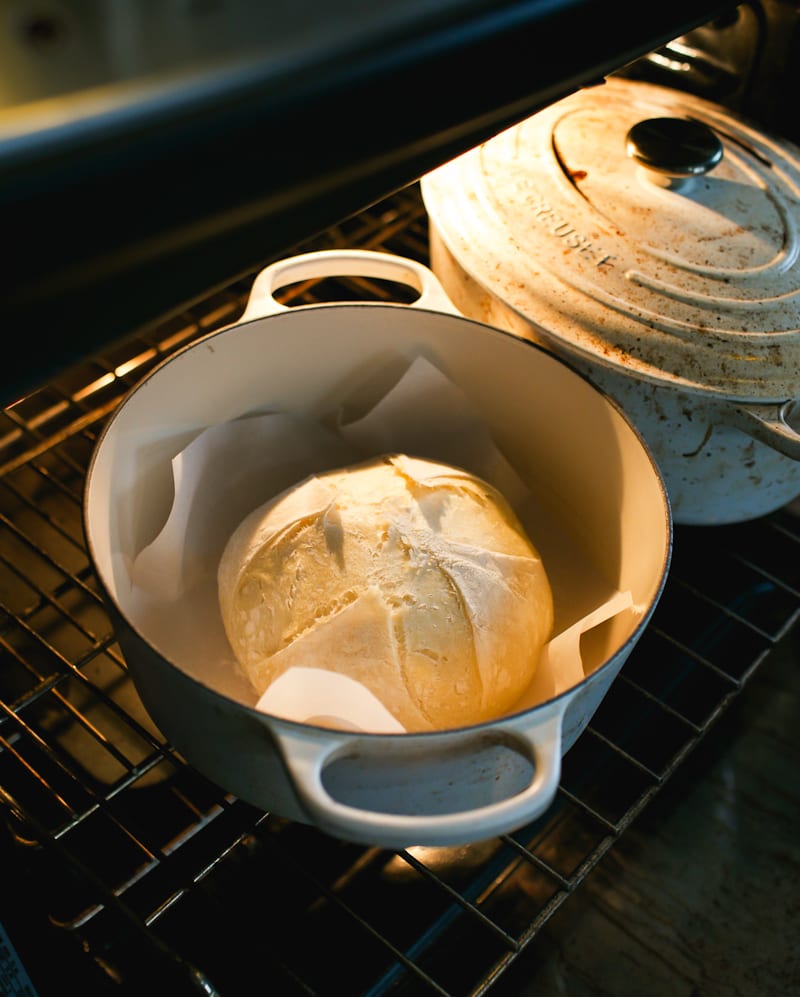
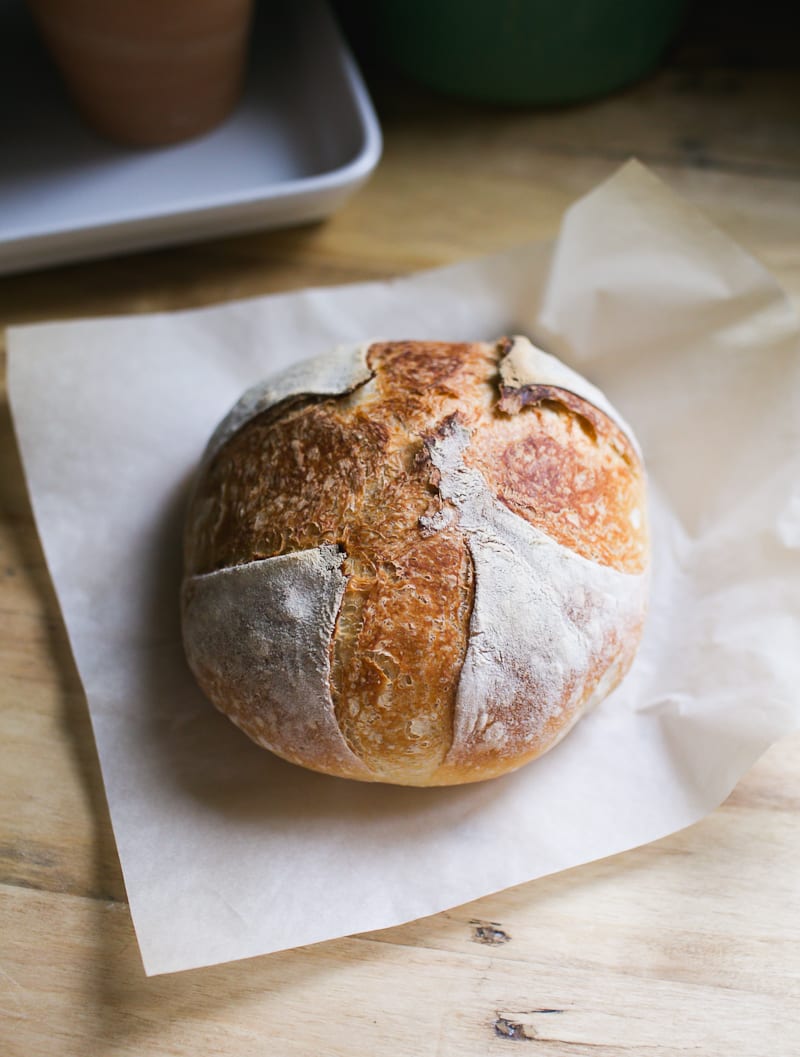
Bake The Bread
Place the Dutch oven into the preheated oven, center rack. Reduce the temperature to 425 F. Bake covered for 20 minutes. Then, remove the lid and continue baking for 30–35 minutes, or until the crust is deep golden brown. Cool on a wire rack for 1 hour before slicing.
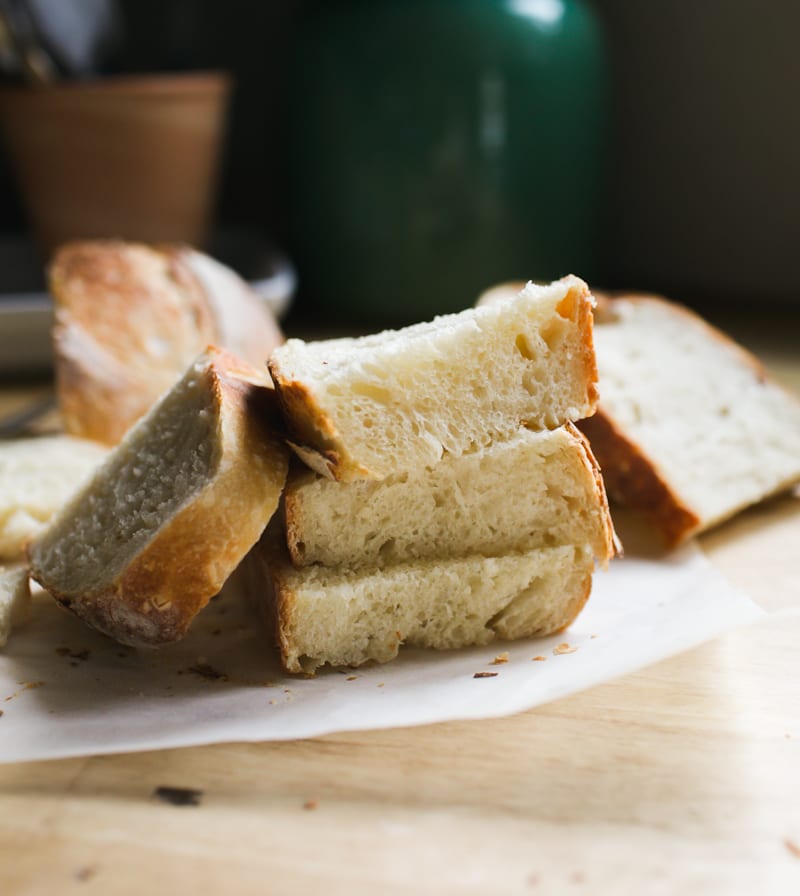
Sourdough Bread Baking Schedule
Here’s a flexible overnight schedule that works well in most home kitchens (around 68°F). If your kitchen runs warmer, simply start a bit later to prevent over proofing the dough.
The Night Before
7:00 PM – Mix the dough and let rest (30 min)
8:00 PM – First stretch and fold (optional)
9:00 PM – Second stretch and fold (optional)
Cover the bowl and let the dough rise at room temperature (10–12 hours)
The Following Morning
7:00 AM – Check the dough (it should be doubled in size)
7:05 AM – Preshape
7:30 AM – Final shape
7:35 AM – Begin second rise + preheat oven
8:05 AM – Bake
More Sourdough Help & Tutorials
- Stretch and Fold Sourdough – Video Guide
- How to Shape a Round Boule – Video Guide
- Light Whole Wheat Sourdough – Next-Level Recipe
- Artisan Sourdough Made Simple – My Book

Artisan Sourdough Bread Recipe with All Purpose Flour
- Cook Time: 50 minutes
- Total Time: 50 minutes
- Yield: 1 small loaf (2-4 ppl)
- Category: Sourdough Bread
- Method: Oven-Baked
- Cuisine: American
- Diet: Vegetarian
Description
No bread flour? No problem! My artisan sourdough bread recipe with all purpose flour is an excellent substitute. This recipe yields a smaller sized loaf (perfect for up to 4 people) with a crisp crust and a smooth, interior crumb.
Notes & Substitutions
This recipe was formulated to work with King Arthur & Trader Joe’s all purpose flour, which contains 11.7% protein. If using another brand, please see my tip in the recipe below for adjusting the texture of the dough, if needed.
For accuracy and best results: please weigh your ingredients using a kitchen scale.
Ingredients
For a small loaf:
- 50 g (1/4 cup) bubbly, active sourdough starter
- 165 g (1/2 cup + 3 tbsp) water
- 5 g (1 tsp) fine sea salt
- 250 g (2 cups + 1 tbsp) all purpose flour (Trader Joe or King Arthur)
For a larger, standard size loaf:
- 50 g (1/4 cup) bubbly, active sourdough starter*
- 330 g (1 1/3 cup + 1 tbsp) water
- 9 g (1 1/2 tsp) fine sea salt
- 500 g (4 1/4 cups) all purpose flour (Trader Joe or King Arthur)
*Note: I use 50 g of starter for both the small AND standard size loaf. Using a smaller amount of starter with an long, overnight rise will help to prevent over proofed dough in the morning.
Instructions
Make the Dough
In the evening, whisk the starter and water together in a large bowl. Add the flour and salt. Mix with a fork until a stiff dough forms, then finish by hand to fully incorporate the flour. It will feel rough and shaggy, and slightly sticky. Cover with a damp towel or plastic wrap and let rest at room temperature (68 F) for 30 minutes.
After the dough has rested, work the dough into a ball. To do this, grab a portion of the dough and fold it over, pressing your fingertips into the center. Repeat, working your way around the dough until it begins to tighten.
TIP: If the dough feels too wet (and this can happen depending on the brand of flour you’re using), add 1 tbsp. of flour. Mix thoroughly by hand, adding more flour as needed. If you think it’s too dry, add 1 tbsp. of water and see how you go.
Bulk Rise
Cover the bowl (damp towel or plastic wrap) and let rise overnight at room temperature. This will take about 10 to 12 hours at 68 F. The dough is ready when it no longer looks dense and has doubled in size. If using a standard 8-inch bowl, the dough will rise about 1/2 way up the sides.
Optional Step: about 1 hour into the bulk rise, do 1 set of stretch and folds. Repeat 1 hour later. This will increase the overall volume of the bread.
Shape the Dough
The following morning, line a small bowl with a cotton or linen cloth. Sprinkle with flour.
Important: You’re going to shape the dough twice to build extra strength.
Preshape
Remove the dough onto a floured surface. To shape the dough into a round, starting at the top, gently fold the dough over toward the center. Give it a turn and fold over the next section. Repeat until you have come full circle. Using a bench knife, scoop up the dough and flip it over (the smooth side should be facing up). Cover and rest for 20-30 minutes.
Final Shape
After the dough has rested, flip it over again (the smooth side should be facing down now). Shape it again following the steps above. Flip it back over. With floured hands, gently cup the dough and pull it toward you in a circular motion to tighten its shape.
Place the dough into the lined bowl, seam side up. Cover the dough with the cloth overhang.
Second Rise
The dough needs to rise again. Rest for 30 minutes to 1 hour. The dough is ready when it looks puffy and has risen slightly, but has not yet doubled in size.
Preheat your oven to 450. Cut a sheet of non-stick parchment paper to fit the size of your baking pot, leaving enough excess around the sides to remove the bread.
Score the Dough
Place the parchment over the dough and invert the bowl to release. Sprinkle the dough with flour and gently rub the surface with your hands. Using the tip of a bread lame, small, serrated knife or a razor blade, make four shallow 4-inch long cuts at 3, 6, 9, and 12 o’clock around the dough. Use the parchment paper to transfer the dough to the baking pot.
Bake the Dough
Reduce the heat to 425 F. Bake the dough on the center rack for 20 minutes, covered. Remove the lid, and continue to bake for 30-35 minutes and golden brown (40 minutes uncovered for the larger, standard loaf).
When finished, transfer to a wire rack. Cool for 1 hour before slicing, for best texture.
Notes
Sourdough is best consumed on the same day it is baked. To maximize freshness, cool completely and store at room temperature wrapped in plastic, reusable beeswax wrap or bread bag for 1-2 days. Sourdough can also be frozen, for up to 2-3 months. Defrost at room temperature and warm @ 300 F before serving.
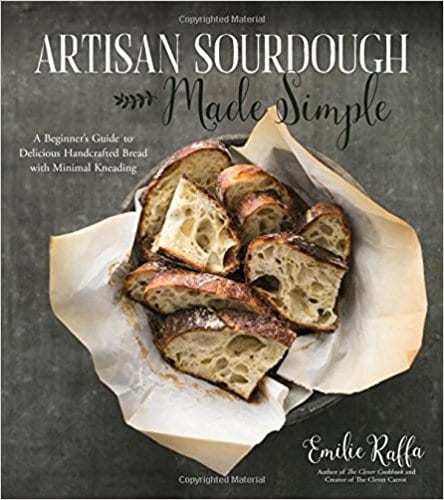

Comments
Amy says
Delicious and sooo much easier than other recipes! I really liked The boat fermenting at night and then shaping it the next day. That really helped my game for sourdough. I’ve definitely got to get your book. Thank you so much for this awesome recipe that I can do now.
Kayla says
Thank you, thank you, thank you! This recipe came out beautifully. It was my very first time making a loaf, so I went with this smaller loaf version, and it’s absolutely delicious! Soft and fluffy on the inside with the perfect crunchy exterior.
Jay says
How much liquid should I use when using Cotswold strong white Canadian flour?
Kari says
I am just getting started with sourdough and am really enjoying your recipes and the process! Quick question. If I’d like to add herbs and cheese to the sour dough, when would I do that?
Briseis says
You would want to add the add-ins while you are doing the stretch-and folds during the bulk rise
Lindsey says
Great recipe! I had no bread flour but my starter was ready to go! I found this recipe and have made twice now. Just a great mellow flavored bread. I do suggest if you preheat your Dutch oven on the small loaf, I only cooked for 25 minutes after taking the cover off. It would have been burnt if it went any longer.
Jesus loves you says
So I was a bit silly and began the bulk rise at 3 pm but I want to bake it in the morning can I just put it in the fridge or will it go wrong?
Thank you
Emilie Raffa says
Hi there! Absolutely. You can use the fridge to “hold” your dough at any point in the process. The cold fridge temperature will slow down the rise giving you more flexibility in your baking schedule. With that said, when ready to continue, you’ll need to assess the dough first before baking: Does it need more time to rise? If so, watch the dough (not the clock) and proceed with the rest of the steps.
BJ Bellamy says
Hi! I seen in the sourdough recipe for using bread flour it includes oil in the recipe and this one doesn’t. Is there a reason for that?
Amanda says
Can you corporate any add ins for this bread? I’m thinking of doing garlic and Parmesan but not sure which step to add it in. Thanks!
Dana Brunner says
Can you let it rise for 4 hours and bake ?
Lisa Marie says
Came out perfectly and am trying for a second small loaf a day later. Will try pretzels next.
Ivone says
I’ve tried making the small loaf , but my bread turns sour . Is it because I use too much of sourdough or it’s kept for rising for long?
Dana Brunner says
Can I pre heat the Dutch Oven ?
Emilie Raffa says
Sure thing. It’s an optional step if you want to include it.🥰
Cass says
Great recipe! easy directions to follow for beginners. I will be sharing the bread and recipe in the future.
Chantal says
My dough is so dense it’s nearly impossible to do a stretch and fold. What have I done wrong? Can it be saved?
Briana says
Where I would start is…. was your starter strong and active? is the temperature of your space warm enough? do you need to let it rise a bit more before your stretch and folds?
Ursula says
I have made this recipe 5 times now, and each time it comes out perfect!!!!
Nicole says
Try moving your rack up one in the oven!
Susan says
How is the bread different if you skip the stretch and folds? Does it taste the same? Is it dense or light and airy?
Brittany says
Love it! Such an easy recipe to follow. Only question I have is, how do you get the bottom to not be so hard when it’s done cooking?! lol. It’s a bit too much for us.
Cooked in a cast iron Dutch oven with parchment paper.
Leah says
I put a cookie sheet underneath my Dutch oven and that helped it not get too hard on the bottom if that helps!
Michelle says
I also sprinkle a little oatmeal on the bottom of the Dutch oven so the parchment paper is resting on that! Not too much though – just a single layer
Kate says
This is the best recipe for my sourdough. I’ve tried many, but this works the best for me, and is delicious! So glad I found you!
Emilie Raffa says
Kate, this is such great feedback thank you! Welcome to sourdough! 🥰
Jim G says
Hi, trying to salvage my mistake of using all-purpose flour (actually 400g AP and 100g rye) for your Dukka bread recipe! So I found your recipe for AP flour, but my dough already has 150g of 50/50 starter. Is there a way to adjust the bulk rise and proofing process? Thanks, I’ve had good success with your light WW sourdough recipe!
Shannon Alexander says
After the final rise, could a person put this in the fridge for a cold proof overnight like a lot of recipes call for?
Emilie Raffa says
Hi Shannon! You can with adjustments. A cold proof is only successful if your bulk rise doesn’t go for too long. Otherwise, the dough will overproof in the fridge on the overnight. So, rise the dough to about 50-75% only, shape, and then chill overnight.
Judy Hoar says
First time making sourdough have made lots of regular breads great receipe turned out awesome thank you!!
Madison Wiggins says
Seriously the best sourdough recipe I have seen. I’ve tried a dozen recipes, with not a great result but this one was perfection. Will be using again!
Jen says
I’m a sourdough newb but didn’t want to commit to having bread flour on hand as I live in a tiny town and it’s not always readily available. This recipe is AMAZING! So easy to follow, great results, all with ingredients I always have in the house. I’ve added mixins to it as well and have had super results.
Leah says
Very delicious, very easy, very forgiving! This recipe always works for me, even though I measure the flour and always add a little whole wheat, sprouted whole wheat, or spelt flour.
Jen says
I made the smaller loaf and it turned out perfectly! I happen to only have Trader Joe’s all purpose flour on hand and wanted to stress bake 🤣the smaller loaf is so cute , and perfect size for my husband and I :)
Macaila Scarano says
Hi! I’ve been following your all purpose recipe for quite some time now. I made my starter 1.5 years ago with all purpose flour. Am I able to transition to using bread flour? Or do I have to make a new starter with bread flour..? Thank you!
Gigi says
I made the recipe you have using the bread flour. It was delicious! I added a teaspoon of honey. I want to try this recipe using all purpose flour but I noticed you don’t include the use of olive oil. Is it ok to add olive oil to this or not? I feel like the olive oil gives it a nice flavor also but maybe it’s excluded when using all purpose flour for a reason?
Paula Kraus says
Wonderful recipe! Do you ever preheat the Dutch Oven before you put the dough in it to bake? Many sourdough recipes do that, and I wondered if that would work for this recipe, or if it is better to put the dough/parchment into a cold Dutch Oven. Thanks!
Devyani says
I just wanted to share that I tried your sourdough bread recipe, and on my third attempt, it turned out really well! Thanks for the great recipe!
Janell says
Great recipe and easy to follow ! thank you
Stephanie Lien says
This is the easiest recipe to follow. I have made about 10 loaves of bread and they were perfect!!! The directions are so easy to follow and the results are fantastic every time.
Thank you!!!
Lecia A Blackmon says
This was my first time making the Artisian Sourdough and it turned out so well. Normally I make your sourdough sandwich bread. Thank you for your good clear instruction. I’ll be making the granola today.
suzanne hogan says
HELP! I make the smaller loaf of this bread in a 31/2 quart dutch oven. My loaf comes out short and squat cause my pan is too big. (the larger loaf is perfect) What size pan should I use for the smaller loaf?
Annie Chalnick says
I am going to make my dough around eight tonight and then will let is rest for a bulk rise but I won’t be able to start shaping until 11 the next morning resulting in a 15 hour bulk rise. Can I put my dough in the fridge to slow down the fermentation process for the bulk rise portion and then continue as normal for the rest of the recipe?
Amanda Desbiens says
Is it OK to allow the bread to sit a while longer on the second rise? I have to leave the house and wondering if it’ll harm the process if it sits 2 hours or more on the second rise before scoring? Thanks!
Melissa says
I love this recipe! I’ve made quite a few other social media influencer recipes and this one was perfect for my starter. This is the only one where I got my bread to rise perfectly and taste just as good.
Emilie Raffa says
Excellent! So great to hear Melissa! Thank you for sharing your feedback. 🥰
Danae Walters says
I have a few questions. I was wondering why you use oil in your recipe with bread flour, but not in this recipe. Also the water amount seems higher to me and you said that you have to reduce the water when using all purpose. Thank you.
Michelle says
How would you time the bake for 150g hoagie rolls, I plan on spraying them with water
Emilie Raffa says
Michelle, this is a great question. I’m afraid I don’t have the answer for your since I haven’t tested it myself. I’m unable to advise with specifics. If you experiment, please let me know!
Lauren says
Hi there!! I didn’t see anything about putting the Dutch oven to preheat. Does it go in or not? Thank you
HMH says
I’ve also read other bakers don’t preheat the D.O. with different success rates…guess it depends on the oven as well?
I have a convection oven and usually have to lower the temperature by 25° to match most recipes… Would love to know if anyone had success with this recipe in a “cold” D.O. ?
JetStream says
I just made my first ever bread with this recipe and I used a cold DO. I started at 450 for 20 minutes covered then 30 minutes uncovered was enough to finish it. Convection oven and enameled DO. Looks perfect and I can’t wait to try it! It looked a like the picture in the recipe after 20 minutes or _maybe_ a little lighter but this is my very first attempt so I’m not a great judge.
Thanks Emily!!
Emilie Raffa says
Excellent! I’m SO thrilled to hear this. Love a good success story. Thanks for your feedback!
JetStream says
I’ve taken a few liberties today (mostly with timing) hopefully everything will still work out. Thanks again and sorry I mis-spelled your name.
Emilie Raffa says
Yes. In fact, it depends on a multitude of factors including sourdough starter vitality, proper dough fermentation (very important), shaping, scoring, oven temp. etc. Preheating your DO only enhances the bake if the previous factors have worked harmoniously together; does that make sense? This takes practice. Hope this helps!
Emilie Raffa says
Hi there! No preheat. It’s common in sourdough baking, but not necessary. You are more than welcome to do so if you are drawn to it.
Bnelli says
Hello, thank you for the recipe! Should the starter be fed or straight out of the fridge?
Emilie Raffa says
Always feed it first. Don’t use it straight from the fridge (see *note below). You’ll need to do this every time prior to making bread dough to re-activate it. For timing, give yourself a couple of days to do so, to perk it back up. *Note: the only exception to using a starter straight from the fridge is if you have fed it at room temperature the day before, placed it in the fridge, and it has become active on the overnight. This is an advanced tip that works with practice and observation.
Janet says
I LOVE the look of your coiled book and your recipes and it’s always with me in this new obsession of mine, HOWEVER, in your recipe of everyday sourdough, you have 350g of water listed (above is 330g) and mine both my attempts were flops. They were too dense & moist inside. A friend mentioned to add more starter next time and this did help. I’m wondering what your thoughts on this might be? I am still giving you 5 stars because, it’s not you and your recipes…it’s me! lol. I’ve made your Country Farmhouse White but added a bit more starter (30g) but it didn’t rise as much but tasted delicious! (perhaps although it was a great starter…maybe needed more strength.). The best so far is your Soft Honey Whole Wheat – this came out so perfect that my mother stole the whole loaf from me after one slice!
T
Kyla C. says
This is my favourite recipe so far. It’s so much easier to have all purpose on hand and I substitute 100g of the flour for whole wheat and it turns out great. I also do half the salt (personal preference). My starter is just from this spring and it does so well having the long counter rise. It also gives great flavour. My baking time/temp is a little different from practice with my oven and what I like. I put the cold DO in at 475 and turn it down to 425. 30 min lid on, 30 min lid off :) thanks for the great recipe
HMH says
Thnk u for sharing your details!
I swear I ve learned just as much from other commenters!
Emilie Raffa says
I know. We have a great community of bakers here who genuinely want to help and support others by sharing their experience with sourdough. Super cool.
Emilie Raffa says
It is. That’s why I created this recipe, for convenience and ease! I like your tip about using 100 g of whole wheat flour. Sounds perfect. Thank you for sharing your feedback, Kyla!
Sarena Quintanilla says
Hi. Small loaf has been the best loaf I’ve ever made consistently in my life. Can the regular size loaf be put into a Pullman pan as is or does the recipe need any tweaking? What temp would you bake and would you need a tray of water and to spray the loaf?
Estrella Harris says
When can I add inclusions?
Nicole Haddow says
I made this last weekend! Best sourdough I have made yet and with all purpose flour! I made two of the larger loaves. Could not bake uncovered for 40 minutes…too long! I think it was in for maybe 20 minutes? I used organic unbleached Robin Hood flour (Canada). After proofing 10 hours, I shaped and placed in bannetons for another 24 hours. Magical! Thank you!
Jennifer Hawkins says
Did you put them in the refrigerator for the 24 hours? And if yes, how long do you let them come to room temperature before putting in the oven?
TIA
Nicole Haddow says
Only until the oven hit temp. I turned it over onto the parchment, scored it, and sprayed it with a little water and put it in.
HMH says
Thnk u for sharing your details!
I swear I ve learned just as much from other commenters!
Good to know someone else in Canada using RobinHood successfully!
Emilie Raffa says
Love this. So great. I can only imagine how much your starter absolutely loves this vibrant flour! The right flour makes all the difference in the world. I’m curious: what is the name of the mill? I’d love to learn about their heritage seed flour.
Nicole Haddow says
All the info is on their site westcountrymills.com
Emilie Raffa says
Hi Nicole! Wonderful! Thank you for sharing ☺️
Amber Provenzano says
Hi there can someone tell me the ratios for making a double loaf of bread using this recipe ? Thank you in advance.
Amber
Frances says
Hi!! Using your recipe as a beginner. I have followed it closely but just realized I have to work in the morning! Is there a way I can follow all the steps, and then put the dough in the fridge after the 10-12 hour rise and after shaping it? This way I can bake it when I get home? Or should I put it in the fridge now and do the shaping tomorrow?
Thanks!!!
Buchman Glenda says
Hi! I’m thinking about doing the same thing. Did it work
for you?
Sarena Quintanilla says
Hi I put my bread in the fridge for the final proofing (after the shaping and in the banneton) 12 hours usually. It’s more sour that way.
Emilie Raffa says
Hi Frances! You can do both, actually. See below for options:
Option #1: Chill the whole bowl of dough overnight (I would cover with lightly oiled plastic wrap so it doesn’t stick to the top). In the morning, shape the cold dough and proceed with the last steps.
Option #2: To chill dough that has been shaped, you’ll need to shorten the bulk rise to about 75% to survive an overnight proof in the fridge. Otherwise, the dough might over proof. If “75%” is hard to visualize, consider purchasing a high-sided dough tub with measuring marks so you can track the dough’s growth as it begins to rise.
Becki R Killion says
I tried with regular flour and King Arthur’s.King Arthur’s was better. I also did not need 4.5 cups flour.Worked best with 4 cups flour.Delicious bread.
Emilie Raffa says
Great! Thank you Becki!
Britt says
The most perfect recipe. I baked a small loaf and the regular size loaf at the same time with this recipe, one for a friend and one for my family. Literally AMAZING. And my loaves look just like the photos. Thank you so much for another perfect recipe!!! I swear by your sourdough guides and recipes, they’re the only ones I use! Thank you, Emilie!!
Becky says
I am new to sourdough baking but this was the best flavor and process so far! Easy enough for a beginner. I’m getting better at it! The instructions are very easy. I like the density that the lower amount of starter and flour gives vs the ratios I was using. The dough is way easier to work with. I started with the smaller version and this morning I baked the big one. Can’t keep my hands off of it!
Carol says
I had a customer ask for a last minute artisan loaf. I found this recipe and went with it because I did not have enough time for my traditional high hydration dough. My starter was running low and REFUSED to get active like usual, but had some signs of activity after some time (was a high ratio feed). I followed your recipe to a T and went with it even though I planned to have the worst flop there was from the start. Woke up the next morning and the dough didn’t look like it did anything (again… used to a higher hydration), but decided to shape it and bake it anyway. The customer messaged me a photo of the crumb (my only requirement since I gave it to her free not knowing how it would turn out) and WOW! It was dang near perfect. This recipe works even for the most ridiculous circumstances that I seemed to have to go through. I’m going to make it for myself next time haha!
Thanks for another great recipe!
Taylor says
Hi! I have been making this recipe for a few weeks now and absolutely love it!! I am looking to add inclusions to the bread (sun dried tomatoes and Parmesan). At what stage would I add these inclusions?
Thank you!!
Senada says
Not sure if you got a response but I’ve been adding inclusions right before cold proofing! It’s come out perfect every time. Might I suggest cinnamon and brown sugar or jalapeño and cheddar was DIVINE as well. This recipe is AMAZING.